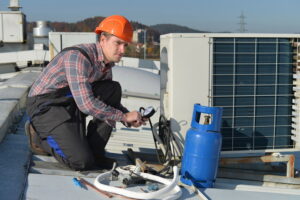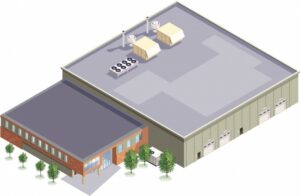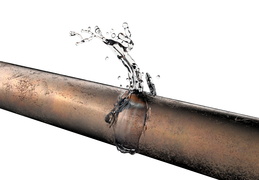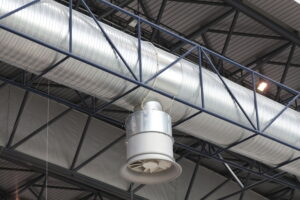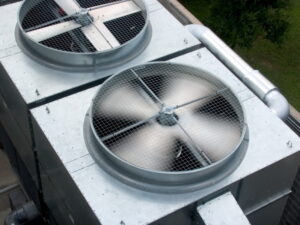Are you ready to start the process of replacing your rooftop HVAC unit? If you answered yes, you may be waiting until spring because you’ve been told no HVAC work can be performed until the outside temperature reaches a certain point. While that’s true, the process of getting an estimate, looking at your budget, choosing the right equipment and getting it installed can take months. This means that if you wait until early May to start contacting commercial HVAC contractors for estimates, you may not receive your new unit until the end of summer.

1. You Need Your New Unit by Summer
If your current HVAC system was malfunctioning or not energy-efficient last year, you’ve probably started thinking about replacing your rooftop HVAC system for the upcoming summer, and you probably think you have another three to four months to start calling contractors because it won’t be hot outside until the end of May. After all, if you’ve ever replaced your home HVAC unit, you know it only takes a few weeks to a month to get it installed. The truth is that commercial HVAC units take much longer to build and ship. This is because commercial heating and cooling equipment, especially rooftop units must be custom-built for the building, and depending on the upgrades and specific customizations needed for your large multi-family residential building, office building or commercial building, you could be looking at a lead time of eight weeks or longer. This means that if you place your order at the front of May, you may not receive your unit until the beginning of August.
2. The Refrigerant is No Longer Available
As of January 1, 2020, R-22 refrigerant is illegal, which means current supplies will deplete because it is no longer legal to manufacture or important Freon in the United States. In your current HVAC unit uses R-22, known by its brand name Freon, it’s a good idea to start considering upgrading your HVAC system to a new model that uses a different refrigerant.
3. Your Unit Has Become Extremely Energy Inefficient
As units age, they become less energy-efficient, which means your utility bills may have skyrocketed over the last few years. If this is the case, it’s probably due to excessively worn parts and a general degradation of the system over time. In order to provide your commercial building with reliable heating and cooling and lower your monthly overhead costs, you may want to consider replacing your unit before the start of the summer.
4. Your HVAC Repairs Are Starting to Exceed 25 Percent of the Unit’s Installation Cost
Have you performed a lot of expensive repairs on your current HVAC system? According to ACHRNews, it’s time to start thinking about replacing your unit if the repair costs to keep the unit running are exceeding 25 percent of its installation cost. Another factor is the unit’s age. Most commercial HVAC systems can be expected to last between 15 and 20 years. If you’ve had upgrades, retrofits and regular repairs performed, you may get as many as 30 years out of the unit. However, once the unit reaches two-thirds of its expected useful life, or is between 10 and 15 years old, it’s time to start thinking about replacing it with a more energy-efficient model.
5. You Want to Take Advantage of the HVAC Tax Credits
If you want to take advantage of the HVAC tax credits for businesses in 2020, you’ll need to start getting estimates for new commercial HVAC systems and rooftop units now. This is because the Tax Cuts and Jobs Act allows businesses to deduct 100 percent of the price of certain business and building equipment, including HVAC systems, but after 2022, this deduction decreases by 20 percent, and it is set to completely expire in 2027.
Getting Your New Rooftop Unit with Althoff, Serving Chicago
When it comes to getting your new commercial HVAC unit installed before the start of the summer cooling season, it’s best to start now, even though the temperatures outside are still freezing. This is because it can take months to receive your unit and get it installed after you choose your new unit.
The process starts with getting an estimate. Here at Althoff, we provide businesses with three estimates for commercial units. The first estimate is typically the least expensive but offers the least energy-efficiency. The second unit is typically midrange, offering a good installation cost and reasonable energy-efficiency, and the third unit typically offers the best energy-efficiency and the most customizations. Since we customize every estimate according to your needs and budget, and our HVAC system designers help choose the best systems, it can take a few days to get your estimate to you. Once you have the estimate, you may have to take it to the building owner or your board members and have them choose and approve the new system and allocate or approve the funding. This can take several more weeks.
Once you make a decision on which type of HVAC system would be best for your building, it can take up to eight weeks or longer to finalize the plans, add customizations and receive your unit from the manufacturer. If you start this process in May, even a quick decision from your board members, building owner or executive management team could result in getting your unit at the end of August instead of the first of June. By contrast, starting the process today by getting detailed estimates, could mean getting your new HVAC unit at the beginning of May, which means you could enjoy the benefits this summer instead of next summer.To learn more about the process of getting a new commercial HVAC system and to schedule a detailed, in-person estimate, give us a call today at 800-225-2443.
Continue Reading

